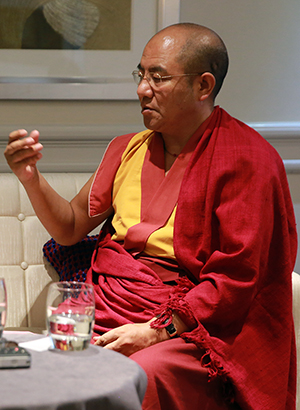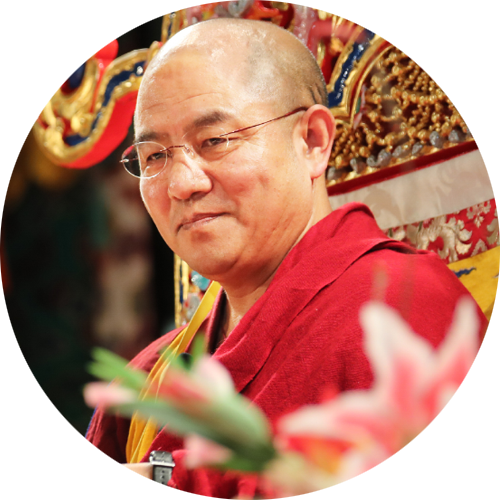Buddhism, Science and Simple Meditation Practice — A Conversation with Dr. William Tuladhar-Douglas
In the conversation, Khenpo offers several simple yet effective meditation practices to both university students and ordinary people. In addition, he provides some guidance for dharma practitioners on how to practice in daily life. As both a Vajrayana practitioner and a university scholar, Dr. Tuladhar-Douglas shares his research on the relationship between Buddhism and science, and his personal experience and the results he’s gained from studying and practicing Vajrayana Buddhism.
When your meditation reaches a certain level, you will be able to meditate anywhere and anytime, either while standing, walking, lying down, or sitting.
A Suggestion for University Students
A Suggestion for University Students
It is very good to offer instruction on The Way of the Bodhisattva in a university. Some schools in my homeland—the Tibetan area—offer a program to study The Words of My Perfect Teacher and The Way of the Bodhisattva . Students may not feel a big difference in the first three or four years; but after graduating, as they enter society and start careers, their lives show a noticeable difference from those of others. So as a suggestion to university students, I hope they can endeavor to study The Way of the Bodhisattva .
Works of Mipham Rinpoche and Longchenpa Regarding Scientific Topics
Mipham Rinpoche produced many works on medicine, some related writings on astronomy, and many treatises on psychology, which are mostly based on traditional spirituality. For example, on astronomy, he wrote an extensive commentary on Kalachakra . He also produced teachings on calendar calculation, which is a branch of astronomy. Psychology is another important topic in his works, which is relevant to daily life. This also includes some topics related to modern management science. Mipham Rinpoche wrote a treatise called Code for Kings . It explains how a king should rule a country, including how to develop the economy, how to govern the nation, and how to guide people to keep their faith and maintain virtuous conduct, etc. Many of his works are concerned with those topics.
Most of Longchenpa’s works discuss the highest level of spirituality—the nature of mind. Works such as Seven Treasures , The Fourfold Heart Essence , are very profound tantric teachings. Longchenpa also produced writings on history and logic. In regard to cosmology, he held his own distinctive views. Longchenpa’s The Wish Fulfilling Treasury is a very comprehensive treatise that covers many topics.
I require my students to study Mipham Rinpoche’s Code for Kings . It integrates both worldly and spiritual teachings, and covers many topics, such as modern management science, political science, and economics, which however, is just in a small part of the text. The book is primarily focused on the management of an entire country including environmental protection and people’s faith and spirituality, etc. I feel for today’s leaders or managers, it is essential to study this text and understand its spirit.

It is very good to offer instruction on The Way of the Bodhisattva in a university. Some schools in my homeland—the Tibetan area—offer a program to study The Words of My Perfect Teacher and The Way of the Bodhisattva . Students may not feel a big difference in the first three or four years; but after graduating, as they enter society and start careers, their lives show a noticeable difference from those of others. So as a suggestion to university students, I hope they can endeavor to study The Way of the Bodhisattva .
Regular Meditation Practice for Ordinary People and Buddhist Beginners
Regular Meditation Practice for Ordinary People and Buddhist Beginners
As for the most important practice for ordinary people, I feel stillness meditation is a good start. Also, for those with some Buddhist background, it is necessary to recite mantras. They can visualize Avalokitesvara or Shakyamuni Buddha in front of them and then recite mantras. They may open their eyes for a while and then just sit there and meditate. For beginners, if they start with this and practice continually, they will be able to maintain a peaceful mind, which is essential.
Should One Do Meditation in the Daytime or Nighttime?
It is a fact that some special practices of Dzogchen, such as gazing into the sky, do require practice in the daytime. However, many other practices, either Mahayana or Tantrayana, do not have such restrictions. So it is fine to do your meditation either at night or in the daytime.
I myself practice in the following way. First, as dharma practitioners, we need to constantly recite mantras and maintain mindfulness. Second, we need to pray. Pray to our deities or gurus in our daily life. Third, we need to do sitting meditation whenever the circumstances allow. I think it makes no difference whether you meditate in the daytime or nighttime. As long as you have the time, you may meditate. When your meditation reaches a certain level, you will be able to meditate anywhere and anytime, either while standing, walking, lying down, or sitting. So as a relatively advanced practitioner, it does not matter whether it’s day or night. Whether it be in the East or West, in the day or night, in a crowd or all alone; all of these do not matter when our meditation reaches a certain level. This is a very important point in the practice.

As for the most important practice for ordinary people, I feel stillness meditation is a good start. Also, for those with some Buddhist background, it is necessary to recite mantras. They can visualize Avalokitesvara or Shakyamuni Buddha in front of them and then recite mantras. They may open their eyes for a while and then just sit there and meditate. For beginners, if they start with this and practice continually, they will be able to maintain a peaceful mind, which is essential.
















